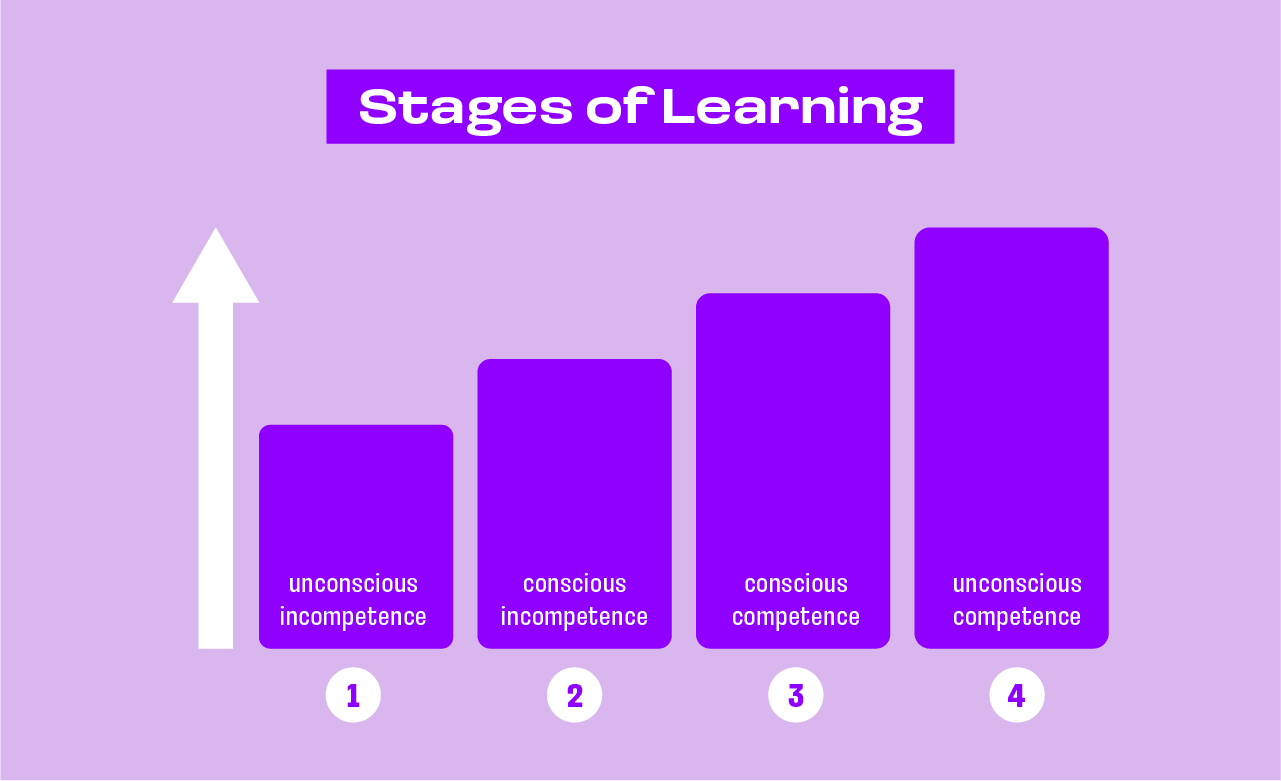4 stages of learning: where are you today?
The author of this article is career & business coach, and co-founder of SOTA Marina Stasevich.
Lifetime employment at a single job is largely a thing of the past. Research suggests that employees now stay with one employer for an average of 4.3 years, holding an average of 12 jobs during their careers. The World Economic Forum’s Future of Jobs Report 2023 says that, by 2027, two-fifths of the core skills of today’s workers will be impacted by technological change.
In a BANI world (Brittle, Anxious, Non-Linear, and Incomprehensible), it’s crucial to develop new competencies, and shift your mindset and behavior as soon as possible to tackle new challenges and quickly adapt to change. To paraphrase advice from Lewis Carroll's “Alice in Wonderland”: “You have to run as fast as you can just to stay where you are. If you want to get anywhere, you’ll have to run much faster.”
Adult learning and development have several critical distinctions: adults are motivated by real-life relevant experiences, prefer self-directed learning, and want to understand why they need to develop.
Mastering new capabilities usually requires behavioral change. It’s not just about understanding new concepts; it's about being able to effectively and regularly act on them.
So, how can you learn effectively? Which method of learning is worth choosing to avoid wasting time and money? The answer depends on your current learning stage.
Mastering a new capability or skill can be easier when you understand the four stages of learning developed by Martin M. Broadwell. His model suggests that there are four stages to learning any new skill:
Unconscious incompetence — when a person doesn’t know how to do something and does not recognize the lack of the skill.
Conscious incompetence — when a person doesn’t know how to do something and recognizes the lack of the skill and the value of acquiring it.
Conscious competence — when the person knows how to do something and has some skill but must concentrate in order to perform.
Unconscious competence — when a person is proficient at doing something and can perform the skill easily without thinking about it.

Stage 1. UNCONSCIOUS INCOMPETENCE: I don’t know what I don’t know
Meet Anna, an enthusiastic new hire. She dives into her tasks with excitement but remains unaware of the gaps in her knowledge and rarely asks questions, resulting in numerous mistakes.
Most efficient methods of development at this stage:
taking online or in-person training with real-life examples and simulations; and
engaging with relevant reading materials.
Stage 2. CONSCIOUS INCOMPETENCE: I know what I don’t know
As Anna delves deeper into her role, she faces new challenges that test her abilities. She starts realizing that there's much she doesn't know. Although this stage can be daunting, it's where growth flourishes.
Most efficient methods of development at this stage:
case-studies;
reading books, listening to podcasts, watching webinars;
mentorship from a more experienced colleague; and
attending workshops and seminars.
Stage 3. CONSCIOUS COMPETENCE: Wow, I actually know what I’m doing
With determination and dedication to skill improvement through formal training and repeated practice, Anna’s competence grows and starts to show. She has learned and practiced enough to perform tasks with a degree of skill and independence. Performing these new tasks still requires from Anna a degree of concentration and effort.
Most efficient methods of development at this stage:
on-the-job practice;
working with a coach;
participation in peer learning groups (e.g. mastermind or action-learning groups); and
networking with other professionals from the industry at meetups and conferences.
Stage 4. UNCONSCIOUS COMPETENCE: I don’t have to think, I just do it
Over time, Anna's skills become second nature and she performs her duties effortlessly like a seasoned pilot navigating the skies. She completes required tasks with ease and speed. Yet, with her proficiency, there's a risk of complacency.
Most efficient methods of development at this stage:
shadow coaching;
strategic sessions, team facilitation, and hackathons;
knowledge sharing and mentoring others; and
brainstorming and panel-discussions.
If you are a Team Leader, you can facilitate the meaningful growth of your team members by recognizing which of these four stages they are in and creating supportive infrastructure:
In the first stage, it's essential to gently shed light on the employee’s blind spots. Create a clear team structure and transparent processes. Provide team members with positive examples to highlight the required behavior and give plenty of positive feedback to keep motivation high.
In the second stage, reassure employees that it's okay to stumble along the way. Give lots of support to combat negative thinking, improve confidence, and refocus energy. Create checklists, and encourage team members to seek resources, ask questions, and embrace a growth mindset. With your guidance and support, they will transform setbacks into stepping stones toward mastery.
Here, it’s important to provide employees with the necessary resources and support that they need to thrive. Offer opportunities for skill-building, give constructive feedback and appreciation, and celebrate progress along the way with your team.
When an employee is at the 4th stage, encourage them to continue refining their skills, embracing new challenges, and expanding their capabilities. Suggest that they share knowledge with peers or mentor junior employees. Additionally, they can now take on the role of a mentor or supervisor for junior team members.
Whether we are looking to develop new skills or achieve career and performance goals, awareness of the four stages of learning and using this framework will help us achieve sustainable growth.


.png)